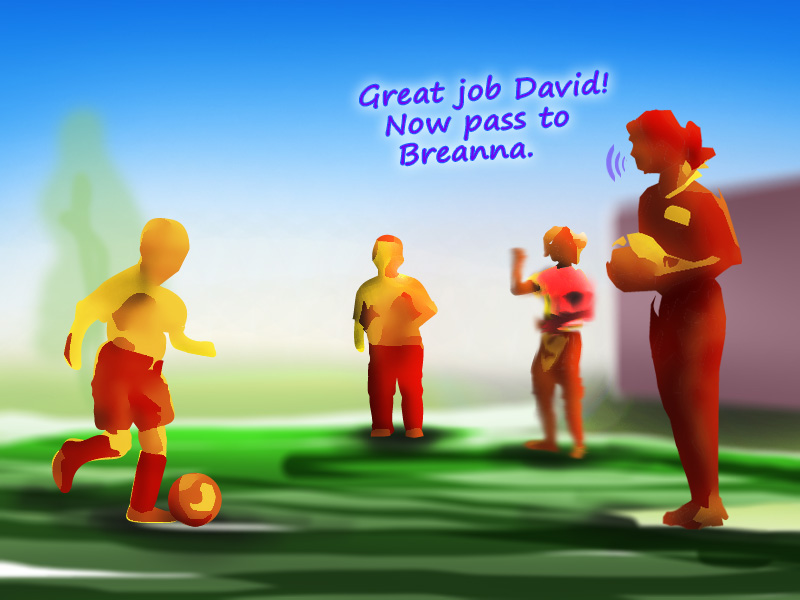- Reflect on the importance of physical activity in your own life.
- Describe the benefits of physical activity for children, families and staff members.
- Describe a program culture that promotes physical activity.
Learn
Self-Reflection: The Importance of Physical Activity in Your Own Life
Most American adults spend a great amount of time sitting. You are probably sitting right now as you read this course. Take a second to check in with yourself. How long have you been sitting? How long do you plan to be sitting while you complete this course? What effect does all this sitting have on your emotional state? How do you feel right now? Are you tired, unenthusiastic or bored? Perhaps you have been on your feet all day and it feels good to sit down.
Now take 10 seconds to do something different. Stand up. Wiggle your toes and reach your arms up over your head. Look away from the screen and roll your head from one side to the other. Do you feel any different after this very short amount of movement?
For most of us, even a very short period of physical activity can improve our energy and outlook. The change may not be drastic, but perhaps you feel like you can pay attention for a little bit longer than you could originally. Obviously, wiggling your toes for 10 seconds is not going to have a meaningful impact on your overall health, but this experience gives you a small insight into the power of physical activity.
According to the U.S. Centers for Disease Control and Prevention, an adult between the ages of 18 and 64 needs at least 150 minutes of moderate-intensity movement (like brisk walking) per week and muscle-strengthening activities on two or more days per week. This level of physical activity can help you:
- Control your weight
- Reduce your risk of cardiovascular disease
- Reduce your risk of type 2 diabetes and metabolic syndrome
- Reduce your risk of some cancers
- Strengthen your bones and muscles
- Improve your mood and mental health
- Improve your ability to complete daily activities and to prevent falls
- Increase your chances of living a longer life
It can be difficult to find the time for physical activity, but clearly the results are worth it. When you are physically active, you are better able to be your “best self.” You have the energy and health to make a difference in your workplace, family, and community.
Understanding Physical Development
Physical development is one domain of development. It relates to the changes, growth and skill development of the body, including the brain, muscles and senses. Physical development is evident primarily in gross-motor and fine-motor skills. These skills are essential to children’s overall health and wellness. Gross-motor skills involve the use of large muscles in the legs or arms, as well as general strength and stamina. Examples of such skills include jumping, throwing, climbing, running, skipping or kicking. Fine-motor skills involve the use of small muscles in the arms, hands, and fingers and are supported by advancements in perception. Examples of such skills include stringing beads, scribbling, cutting or drawing. Fine-motor skills enable children to perform a variety of self-help tasks such as using utensils or dressing themselves.
 Children’s motor abilities develop as a result of physical development and growth. As their bodies mature over time, children progressively strengthen their muscles and become able to better control their bodies. Skill mastery and development, however, are also the result of brain growth and development. Consider a preschooler kicking a ball back and forth with a peer. This child must have acquired control over movement and muscles to be able to kick the ball. At the same time, the child also depends on vision to determine the location and direction in which to kick the ball and on hearing for instructions from a peer or caregiver. As children move through the school-age years, their bodies and minds become capable of increasingly more-complex movement patterns and experiences.
Children’s motor abilities develop as a result of physical development and growth. As their bodies mature over time, children progressively strengthen their muscles and become able to better control their bodies. Skill mastery and development, however, are also the result of brain growth and development. Consider a preschooler kicking a ball back and forth with a peer. This child must have acquired control over movement and muscles to be able to kick the ball. At the same time, the child also depends on vision to determine the location and direction in which to kick the ball and on hearing for instructions from a peer or caregiver. As children move through the school-age years, their bodies and minds become capable of increasingly more-complex movement patterns and experiences.
Physical Activity for Staff, Children, and Families
The mental and physical health benefits of activity are extensive. You have read about how important physical activity is for yourself. The same holds true for the staff members, families and children with whom you work. Let’s explore each group.
Importance of Physical Activity for Staff Members
Physically active staff members make a difference for a variety of reasons:
- Physical activity promotes health. When staff members are active and healthy, they should have fewer missed days due to illness.
- Physical activity decreases stress and promotes mental well-being. This means staff members might be better able to handle the pressures of their jobs and family life. This includes being able to have positive interactions with children and families in the program.
- Staff members are role models. It is important for children and youth to see adults engaging in healthy habits like exercise. Children are more likely to participate in physical activities when they are surrounded by others who are interested and engaged.
Importance of Physical Activity for Families
- Being physically active together can be fun for families. A long walk, hike or bike ride can create meaningful memories for children and parents. Physical activity is also an inexpensive way for families to connect. Choosing to take the stairs together is free!
- When parents engage in physical activity, they experience health benefits. These benefits might include weight loss and control, reduced risk of cardiovascular diseases, and enhanced mental health. Parents pass these health benefits on to their children when they model physical activity and if the family is active together.
Importance of Physical Activity for Children
Children who are physically active are more likely to stay at a healthy weight, sleep better, maintain strong bones, and avoid obesity-related diseases. Children who are physically active also have more opportunities to develop muscle strength and endurance. They are more likely to feel confident about themselves and their bodies as they grow (Let’s Move Child Care, 2013).
Physical activity also provides children with access to learning across domains. An infant who rolls over or pulls up expands access to the surrounding world. That child can look at, touch, and taste a wider array of objects. A preschooler who jumps in puddles is exploring concepts of physics. A school-age child who joins a group soccer game is broadening his or her social connections.
The negative consequences of inactivity for children are stark. Children are explorers, and their brains develop through activity and movement. Children who are not active are more likely to have behavior problems in school or to have trouble with academics.
Creating a Program Culture that Promotes Physical Development
Now that you have learned the importance of physical activity for yourself, staff, families, and children, it is time to think about how your program can promote physical activity. Throughout this course, you will hear from staff members, administrators, and training and curriculum specialists from exemplary programs. Think about how you can apply what you see to your own work.
Programs that Promote Physical Activity
Completing this Course
For more information on what to expect in this course and a list of the accompanying Learn, Explore and Apply resources and activities offered throughout the lessons, visit the Training & Curriculum Specialist Physical Development Course Guide.
To support the professional development of the direct care staff members or family child care providers you oversee, you can access their corresponding Course Guides:
- Infant & Toddler Physical Development Course Guide
- Preschool Physical Development Course Guide
- School-Age Physical Development Course Guide
- Family Child Care Physical Development Course Guide
Explore
The Healthy Kids Healthy Future website https://healthykidshealthyfuture.org/trainers/ has developed a variety of tools to help children, adults, and communities become more active. To get a baseline read for how well your program incorporates physical activity into its program, review the Healthy Kids, Healthy Future Checklist Quiz. After you take the quiz, reflect on what your program is currently doing. Make notes about your program’s strengths and where it could improve.
Apply
Browse the online resources below for ideas about promoting physical activity. Share the resources you find with families and staff members.
Resources to Promote Activity
- After-School Energizers
http://www.nchealthyschools.org/docs/energizers/afterschool.pdf
Provides ideas and suggestions for building activity in school-age programs. - Active Schools
https://www.activeschoolsus.org/news-and-resources/
Useful information including a links to research, resources, and grants - Healthy Kids, Healthy Future
https://healthykidshealthyfuture.org/about/
Empowers child care and early education providers to make positive health changes. - NFL Play 60
http://www.nfl.com/play60
This website offers videos, ideas, and opportunities to help children engage in active play for 60 minutes per day. - National Association for Sport and Physical Education
https://www.shapeamerica.org/publications/resources/teachingtools/teachertoolbox/Teachers_Toolbox.aspx
This website provides a “Teachers Toolbox” with ideas for promoting physical activity.
Glossary
Demonstrate
Centers for Disease Control and Prevention. (2011). Physical Activity and Health. Retrieved from http://www.cdc.gov/physicalactivity/everyone/health/index.html
Copeland, K. A., Kendeigh, C. A., Saelens, B. E., Kalkwarf, H. J., & Sherman, S. N. (2011). Physical activity in child-care centers: do teachers hold the key to the playground?.Health education research, 27(1), 81-100. Retrieved from https://www.ncbi.nlm.nih.gov/pmc/articles/PMC3258280/
Kids Health Nutrition & Fitness Center. (2014). Retrieved from http://kidshealth.org/parent/centers/fitness_nutrition_center.html
Let’s Move! Child Care. (2013).
Let’s Move! (2014).
Playworks. (2020). Game Library. Oakland, CA: Sports4Kids. Retrieved from https://www.playworks.org/game-library/
The Nemours Foundation. 2020. Healthy kids, healthy future. Retrieved from https://healthykidshealthyfuture.org/
Sanders, S. W. (2002). Active for Life: Developmentally appropriate movement programs for young children. Washington, DC: National Association for the Education of Young Children.
2018 Physical Activity Guidelines Advisory Committee. 2018 Physical Activity Guidelines Advisory Committee Scientific Report. Washington, DC: U.S. Department of Health and Human Services. Retrieved from https://health.gov/our-work/physical-activity/current-guidelines
U.S. Department of Health and Human Services (U.S. HHS). Office of Disease Prevention and Health Promotion. (2018). Physical Activity Guidelines for Americans. Retrieved from https://health.gov/paguidelines/second-edition/ and https://health.gov/paguidelines/second-edition/pdf/Physical_Activity_Guidelines_2nd_edition.pdf


